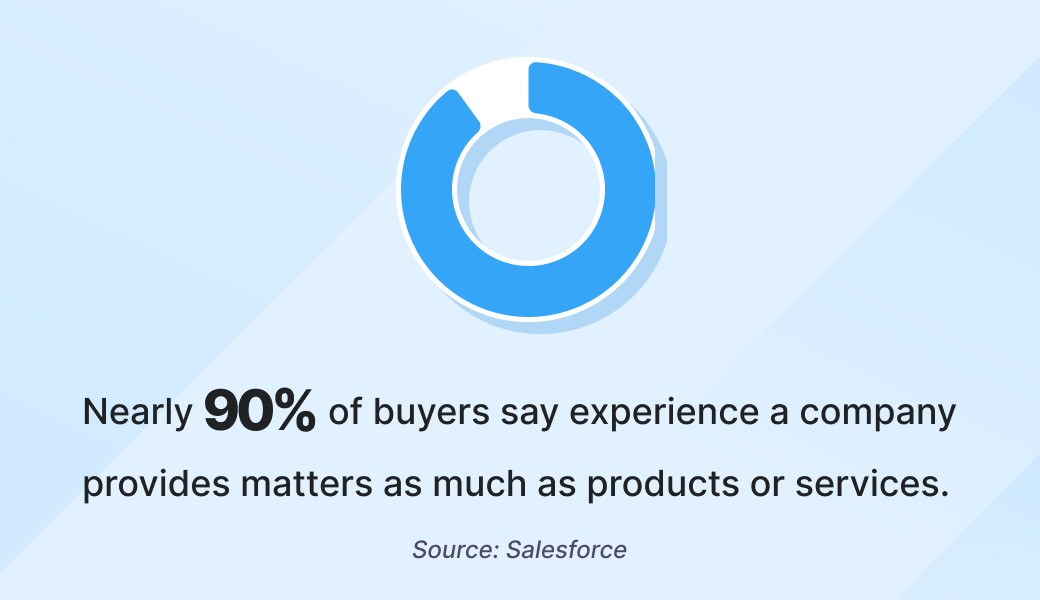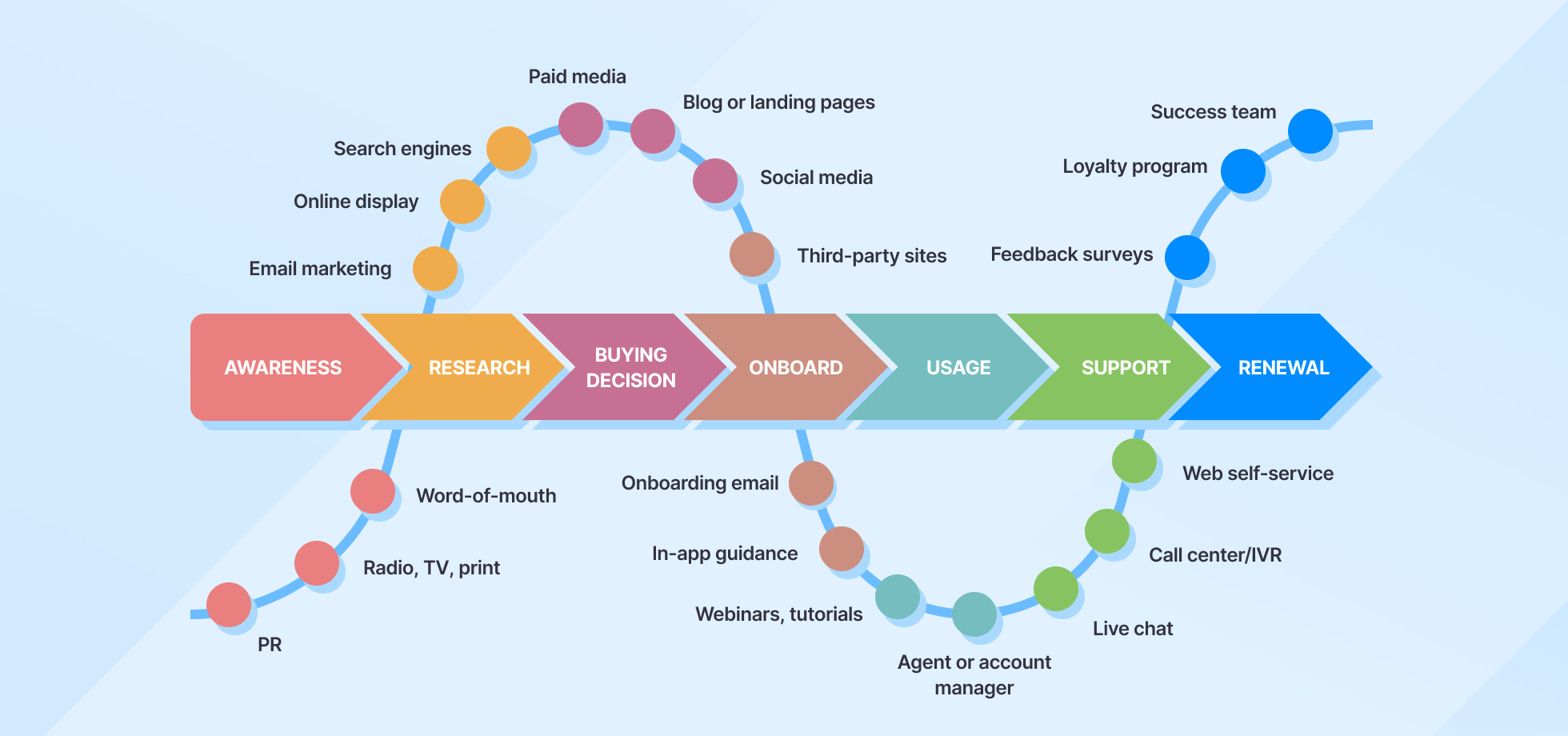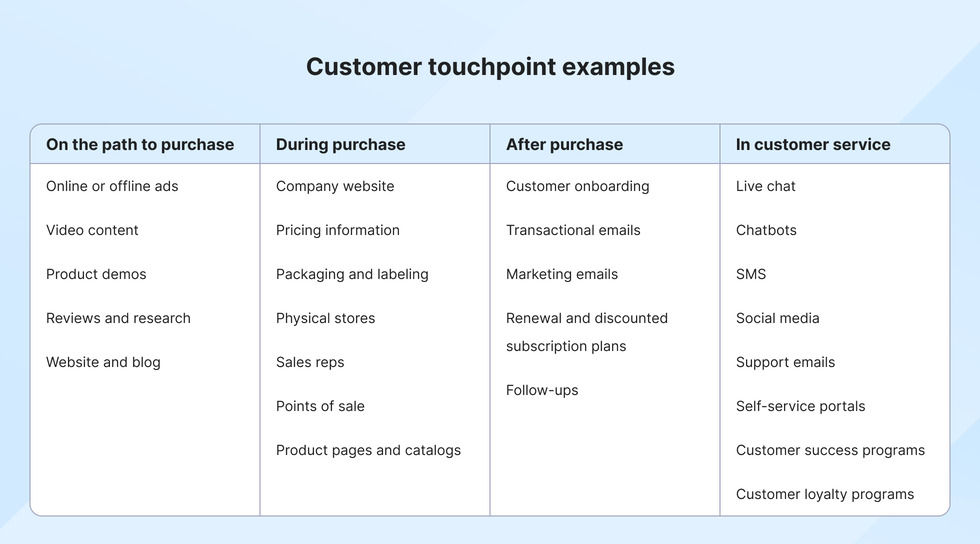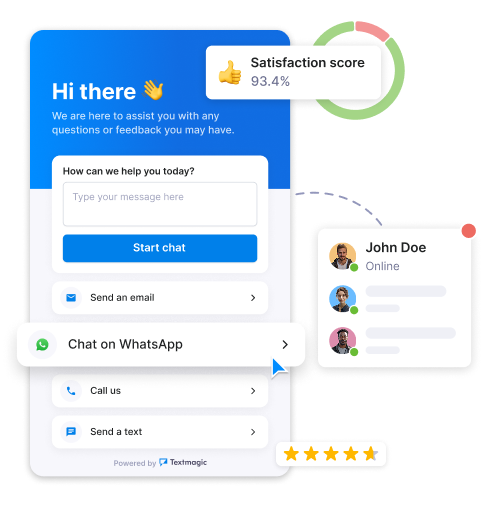
Customer touchpoints have the potential to turn a lead into a prospect and a one-time customer into a recurring one. Every stage of the customer journey is marked by touchpoints you can use to provide value to your leads, turning them into customers and, if all goes well, into brand advocates.
Delivering exceptional experiences at every touchpoint is key to building lasting customer relationships and maintaining brand loyalty. A recent study states that 88% of customers now consider the experience offered by a company to be just as significant as the quality of its products or services.

This article will teach you how to identify the most important customer touchpoints and make the most of their lead-nurturing potential up to the point where customers become lifelong investments.
What are customer touchpoints?
A customer touchpoint is any type of contact a customer engages in with your brand. Touchpoints can be direct (websites, SEO, advertising, email marketing, etc.) or indirect (social media, blogs, forums, reviews, etc.) and may happen at any point in the customer journey — before, during, or after a purchase.
Why are customer touchpoints important?
Each customer touchpoint represents your brand’s opportunity to increase customer retention. You can engage clients using targeted communications throughout their relationship with your brand, which can move them further along the sales funnel.
Every stage of the journey calls for different interactions, starting with awareness and ending with ongoing customer support and loyalty programs.
Here is how your business can benefit from identifying customer touchpoints and sending targeted communications to your clients at the right time to increase conversions.
- Improved brand image: By guaranteeing that customers encounter a seamless and hassle-free journey across all channels, you create a more positive perception of your business.
- Repeat purchases: Personalized communication significantly influences how likely customers are to return to your company for future purchases.
- Increased loyalty: Customer satisfaction lays the foundation for building a loyal customer base that continues to support your brand.
- Reduced customer service stress: Smooth customer interactions at every touchpoint lead to higher first contact resolution rates. This streamlines the workflow for your customer service team, making their jobs more manageable.
How to identify customer touchpoints
Analyzing interactions with your audience is essential to pinpointing and mapping customer touchpoints. Here’s a step-by-step guide to kickstart the process.
1. Understand your target audience
Are you familiar with your target audience’s characteristics and preferences? Are you present where they typically engage?
It’s important to recognize that as your business evolves, you may need to introduce fresh touchpoints (like launching an account on a new social media platform or implementing a chatbot on your website) to connect effectively with your target audience.
💡 Take into account the specific requirements of your audience. For instance, if you operate in the SaaS industry, consider providing customized features or discounts to encourage current users to recommend your software to their colleagues or network.
2. Find patterns in customer interactions
Step into your customers’ shoes and consider questions such as:
- How do I choose where to buy something?
- Where do I go for assistance when facing issues with a purchase?
- How do I stay informed about the latest products or services?
- Where do I share my thoughts on a positive or negative purchase?
These answers reveal where your customers interact with your brand most frequently, where your business should connect with them, and when to seek their feedback.
3. Create a touchpoint map
Creating a touchpoint map is a strategic exercise that involves visualizing every main point of contact throughout your customers’ journey with your brand, product, or service.
To begin, gather data and insights about customer interactions at various stages. Then, plot these interactions on a customer journey map, detailing the customer experience from awareness to advocacy.

🗺️ A touchpoint map can pinpoint areas for improvement in your product, service, customer experience, and/or overall business strategy.
4. Organize your touchpoints into different groups
Once you’ve crafted your touchpoint map, you can divide each customer interaction into specific categories. It is best to divide these touchpoints into three distinct groups: before, during, and after a purchasing decision. This categorization simplifies the process of pinpointing those touchpoints that require enhancement or addition.
In the next section, let’s explore some examples of these categorized customer touchpoints.
Examples of customer touchpoints
Customer touchpoints can vary significantly from one company to another. For instance:
- If you run a retail business, the customer’s journey may involve exposure to ads and navigating through your website’s sales funnel. Also, engaging with the in-store team during a visit represents a crucial aspect of retail touchpoints.
- If you operate in the SaaS industry, your customer touchpoints might be represented by advertising campaigns, interactions with your marketing team, conversations with sales representatives, and/or onboarding processes.
Customer support and feedback mechanisms should be part of your touchpoint strategy regardless of your business type. Being creative and having clear objectives for each brand touchpoint ensures you’re building a purposeful and tailored relationship with your customers.
Here are some examples of customer journey touchpoints based on the specific stage:

Customer touchpoints on the path to purchase
The main stages included in your client’s path to purchase are awareness, consideration, and decision. Some examples of customer touchpoints within these three stages are presented below.
1. Online or offline ads
Online ads on social media channels, search engines, and websites capture potential customers’ attention during digital interactions. On the other hand, offline ads, such as billboards, print media, and television commercials, can reach a broader audience. These advertisements aim to create interest and curiosity.
2. Video content
This type of content provides an interactive touchpoint for customers. Video ads can capture attention and drive awareness. Instructional tutorials like webinars and podcasts help customers consider your product or service as a solution to their needs.
3. Product demos
Offering product demonstrations during conferences, for example, is a hands-on approach to engaging potential customers. These demos provide a tangible experience and help customers move from the consideration to the decision phase.
🤝 Effective product demonstrations showcase the value and benefits of your offering, making it easier for customers to choose you.
4. Reviews and forums
Potential customers often turn to reviews, testimonials, and online forums to gather insights about products or services. This preliminary research allows them to make more educated decisions. Businesses that provide accurate and helpful information during this phase can positively influence customers’ decision-making processes.
5. Company blog
Blogs provide opportunities to showcase expertise and address customer pain points. The key is offering information that someone wouldn’t normally have until after buying and using the product. Authenticity draws customers in, so mentioning some of its flaws or drawbacks makes the product look more genuine.
Customer touchpoints during purchase
Whenever a customer makes a purchase, every sales and marketing activity related to it and every member of staff they come into contact with constitutes a customer touchpoint.
During the purchase, customers have very specific expectations that you need to fulfill to ensure that they purchase from your brand. This is where understanding the significance of touchpoints becomes crucial. Here are some key interactions to focus on during this stage.
6. Company website pages
Well-designed, mobile-responsive landing pages with user-friendly navigation and interactive elements like digital flipbooks can captivate visitors. If website visitors struggle to locate the information they need, they’ll likely give up and try elsewhere.
7. Pricing information
Transparency in pricing is essential to meet customer expectations. Clearly display your pricing structures, discounts, and any additional costs associated with the purchase. Avoid hidden fees or surprises that could discourage potential buyers.
🛍️ Consider offering the option for customers to try out the product for free. This helps establish brand trust.
8. Packaging and labeling
The packaging and the labeling of your products are tangible purchase touchpoints. If you want to leave a positive impression, invest in eye-catching, informative packaging that enhances the perceived value of your products.
9. Physical stores
If you have physical locations, these serve as critical touchpoints during the purchase process. Ensure that these stores offer a welcoming ambiance, organized displays, and are run by knowledgeable staff. Create an inviting and well-thought-out environment that aligns with your brand’s image.
10. Sales reps
When customers engage with sales reps, they expect expertise, empathy, and guidance. Incorporate active listening skills to ensure a personalized and positive sales experience that caters to each customer’s unique requirements.
11. Points of sale
The checkout process should be efficient, secure, and user-friendly. Ensure that customers can easily complete their purchases, receive clear receipts, and have access to support or assistance if they need it.
12. Product pages and catalogs
These assets should be informative and visually appealing, featuring high-quality images, detailed product descriptions, and authentic customer reviews. Clear and concise information on these pages helps customers make informed decisions.
Customer touchpoints after purchase
Once a customer completes a purchase, it’s essential to maintain a positive relationship with them. Here are various digital touchpoints through which you can keep them engaged.
13. Customer onboarding
Customer onboarding is a crucial stage because many customers tend to stop using products shortly after purchase. This happens because they either lack the know-how to use the product or don’t have the time to learn. Both scenarios can lead to customer churn, so being there for the customer during their onboarding should be a priority.
14. Transactional emails
These emails are valuable touchpoints, delivering order confirmations, shipping updates, and receipts. Transactional emails provide essential information while offering an opportunity to cross-sell or request feedback.
15. Marketing emails
Post-purchase marketing emails are a great means of staying connected with customers. By sharing relevant content, product recommendations, and/or exclusive offers, you can continue to engage customers, keeping them informed about your brand. These marketing touchpoints extend the customer journey beyond the purchase.
16. Renewal and discounted subscription plans
Streamlined renewal options ensure a hassle-free experience for existing customers. Providing discounts and/or special plans incentivizes customers to stay engaged and committed to your brand.
17. Follow-ups
Post-purchase follow-ups show your commitment to customer satisfaction. Whether you’re seeking feedback, offering additional support, or checking in on their experience, follow-up touchpoints like in-app notifications and tutorials demonstrate your dedication to ensuring a positive post-purchase journey.
Touchpoints in customer service
Customer service plays a very important part in every customer’s journey along the sales funnel. Here are its main touchpoints and how they help keep clients happy with your product or services:
18. Live chat
Live chat support is a preferred channel for business interaction. It offers immediate results, is easy to use, and is less time-consuming than other channels. This communication method works so well because it immediately increases customer satisfaction and decreases bounce rates.
With 41% of customers expecting to see a live chat section on your site, the only option for keeping them happy is to provide one, if you haven’t already. Customer service tools can help you configure your live chat widget in minutes.
Try our omnichannel chat widget for free
Chat, text, or email, connect the way your customers prefer.

19. Chatbots
Chatbots allow you to offer more support to your clients, meeting them at more touchpoints along their sales journey. This type of support enables you to provide 24/7 support and resolve common client queries with zero need for human intervention.
With chatbots, you can even offer possible answers before the client has finished typing, which translates into faster support and a lower workload for your call center agents.
20. SMS
This is a very versatile customer service tool that you can use throughout the customer journey, starting with the awareness stage. Unlike other channels, texting offers the added benefit of being cost-effective.
It is the easiest way to stay in touch with potential and current clients because it is read almost instantly. It works well for both customer engagement and support and enables the sending of strategic messages to your clients anytime, anywhere.
21. Social media
Social media has emerged as a vital customer service touchpoint. It provides a direct and convenient channel through which customers can reach out to you with their inquiries, feedback, and/or complaints.
Social media enables you to showcase your responsiveness and commitment to meeting your customers’ needs. With social media analytics, you can gather valuable insights from customer interactions.
22. Support emails
Support emails serve as an invaluable customer service touchpoint. They offer a flexible and convenient means of communication that accommodates diverse schedules and time zones.
Support emails provide a documented trail of communication, which aids both your customers and your teams in resolving issues efficiently. You can track and analyze these emails to identify recurring problems, ultimately leading to process improvements and better service quality.
23. Self-service portals
Another valuable touchpoint is offering self-service options like FAQs, knowledge bases, and tutorials. They empower customers to find answers independently, reducing their need for direct assistance and enhancing their perception of your brand.
24. Customer success programs
When the customer success team identifies a potential issue, they proactively contact the customers to inform them and provide solutions. Spotting possible trouble ahead, rather than waiting for angry customers to complain, showcases your dedication to satisfying your customers and, over time, strengthens your relationships with them.
25. Customer loyalty programs
Customer loyalty programs are vital in building strong customer relationships and transforming new customers into lifelong advocates. Through exclusive rewards and discounts, these programs encourage customers to share positive product reviews about your business.
How to craft a customer touchpoint strategy
After you’ve correctly identified your customer touchpoints, the next step is to include them in your business strategy and fully profit from the insights they offer. Here are the most popular ways to increase customer satisfaction and spark business growth using the most popular customer touchpoints.
1. Spot missed opportunities
Start by conducting an analysis of customer behavior, preferences, and feedback at each touchpoint. The data you collect may unveil gaps in engagement that may have been previously overlooked.
2. Recognize high-value touchpoints
Not all touchpoints in your marketing campaigns hold the same significance. After thoroughly analyzing the insights from each touchpoint, pinpoint the areas where you can most effectively focus your marketing efforts.
3. Maintain consistency on all platforms
To improve the customer experience and uphold a strong brand identity, ensure that every customer interaction reflects the company’s values. Use the same fonts, colors, and logos for consistency when creating marketing materials.
💡 Offer standardized training for customer support teams and sales representatives to ensure that they deliver consistent customer expertise and service.
4. Reevaluate customer touchpoints
Keep an eye on touchpoints that engage customers. Ongoing monitoring of touchpoints that drive customer interaction can guide improvements and create new engagement strategies. Adapt to the evolving customer onboarding trends by revising touchpoints as needed.
Leverage digital touchpoints to improve CX
Using touchpoints helps you create a full customer profile. With effective touchpoints and data systems, you can gain a deep understanding and the ability to predict trends and reactions. Leveraging customer touchpoints allows you to actively participate in every phase of the customer journey.
Trusted by teams that never miss a message
Connect via chat, text, email, WhatsApp, and social, all in one dashboard with Textmagic.

Textmagic is a great platform designed to elevate customer experiences. Its core strength lies in its capability to centralize and streamline customer interactions across all digital touchpoints. With its multichannel capabilities and AI-powered engine, Textmagic facilitates seamless communication between your business and your customers.
Adopt a thoughtful approach to enhancing customer touchpoints today. After all, stronger customer connections pave the way for business growth.
Frequently Asked Questions (FAQs)
Key touchpoints include brand discovery, website visits, customer service interactions, purchase experiences, and post-sale communication. Each moment influences how customers perceive your brand.
Emotional touchpoints are moments in the customer journey that trigger feelings, such as excitement, frustration, or trust. They often occur during support interactions, product use, or onboarding and can strongly impact loyalty.
Touchpoints tied to customer success include onboarding, training, feature updates, support responses, and renewal or upsell conversations. These ensure customers get ongoing value and stay engaged with your product or service.
It typically takes 6 to 8 meaningful touchpoints to convert a prospect into a customer. The number can vary depending on the complexity of the product, industry, and sales cycle.
The five main stages are awareness, consideration, purchase, retention, and advocacy. Each stage includes distinct touchpoints that shape the overall customer experience.
Related articles
What is call masking and how can it benefit your business?
Have you ever had to call your food delivery courier...
15 Apology email templates that signal professionalism and best practices
An apology email to customers serves as a crucial to...
60+ SMS and email statistics: Why using both channels works better
SMS gets opened by 82% of recipients within minutes....
5 Ways to get the most out of your Textmagic trial
Not sure if business texting is right for you? Sign ...
SMS spoofing explained and how to avoid being a victim
Concepts such as SMS spoofing, smishing, and phishin...




